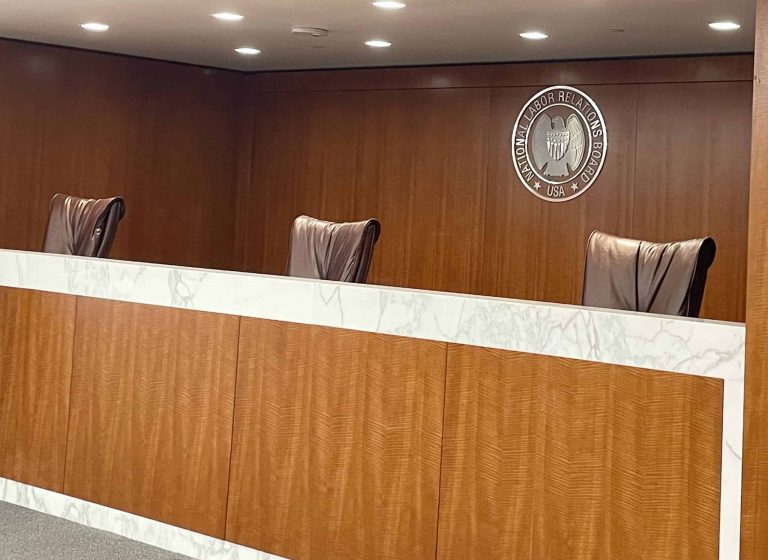
Nathaniel Levy is a student at Harvard Law School and a member of the Labor and Employment Lab.
Workplace ableism is hostile to employees with disabilities
Imagine, if you will, a woman in her 30s with a masters degree who works for a healthcare research non-profit. She has Crohn’s disease and fibromyalgia, so the routine activities of a weekday can, at times, be tiring. After showering or getting dressed, for example, she sometimes takes a rest. At the office, she closes her office door a few times a day so that she can close her eyes or do therapeutic exercises. She’s fortunate to have her own office, but isn’t so lucky when it comes to parking. She hasn’t spoken to her manager about getting tags that would permit her to park closer to office entrance and spare her a twice-daily walk up a few slights of steps.
Like this woman, lots of employees with disabilities often experience work as inhospitable or incompatible with their preferred ways for dealing with their symptoms, despite the protections of the ADA. Although individual experiences vary greatly, virtually all employees run up against cultures of workplace ableism. In industries that lionize long, grueling hours—tech and law, for example—employees contend with cultures of hyper-ableism.
There’s no single definitive definition of ableism. That’s to be expected—after all, racism, sexism, and classism can all be explained in different ways, but there’s no doubt that they refer to real-world phenomena. Ableism has been alternatively defined as a “set of … stereotypes about people with disabilities that acts as a barrier to keep them from achieving their full potential as equal citizens in society,” and as a “system of oppression that favors able-bodiness at any cost.” The examples that follow illustrate how some who have “invisible” disabilities experience workplace ableism. Invisible disability consists of impairments that are not readily observable, and which result from mental or chronic illness. But first, two caveats. Invisible disability (like disability broadly) is a diverse category — these examples don’t define the field of who’s included. Further, the post’s argument may be just as applicable to those with visible disabilities. These examples merely reflect the research that informed this post.
Consider the subtle, as well as the not-so subtle, ways that ableism manifests at work. For instance: (1) An employee at a public health non-profit who has for years dealt with spondylolysis gets back pain after sitting for stretches. Uncertain how to approach a supervisor about accommodation, this woman would instead stack chairs at her cubicle’s entrance so that she’d be unseen while doing physical therapy stretches. (2) John, a software engineer with bipolar disorder and a genetic disorder called Fabry disease, which can result in chronic pain, was told during a job interview with Microsoft during that he needed to spend more of his free time coding. The interviewers were not discriminating against John because of his disability, but they were unambiguously expressing a conception of the ideal worker as one whose body sustains work performance nearly all the time. (3) In a case that ended up in litigation, a medical resident was open with her reviewer about having serious depression, anxiety, and PTSD, and about the effects of residency’s demands on her mental health. The reviewer told her that she couldn’t “expect coddling,” and warned that “some people are just not strong enough for this profession.”
Episodes like these occur within a culture that characterizes professional success as a function of extreme work. While many white-collar workers with invisible disabilities quietly receive signals that their conditions are deficiencies, multiple CEOs of big tech companies — Elon Musk and Jack Ma, for example — have notoriously tried to normalize extreme 70- or 80-plus-hour workweeks. In response, some tech workers and disability advocates have argued that such efforts produce dignitary harm and have a disparate impact on disabled employees. They also argue that grueling hours are bad for the bottom line.
The combination of workplace ableism and the design of the ADA discourages employees with disabilities from accessing and benefiting from their legal rights.
Workplace ableism can be stigmatizing, and disincentivizes employees with disabilities from initiating conversation with their employers about accommodations. Like John, some fear being viewed as incompetent. Cases like the medical resident’s understandably reinforce that fear — knowing that you could fight for your rights in court doesn’t necessarily alleviate the fear of insult or humiliation. Others, like the non-profit employee with chronic back pain, might be uncertain whether they really want to claim the “disabled” label due of a complicated cocktail of emotions, including internalized stigma, fear of a negative reaction, guilt that they are “less disabled” than others, and reluctance to do the emotional labor of advocating for oneself.
Advocating for yourself at work is itself hard work. Educating managers and coworkers about disability on top doing your regular work can be draining. HR departments aren’t always equipped to lighten that load, and many covered employers may not have an HR department at all. Further, this emotional labor can be greater for women with disabilities in “male-dominated work environments that valorize masculine traits”—like law—as Michelle Travis explains in a 2017 law review article. (Travis cites a study of women with disabilities in various settings of legal practice, from firms to public-interest jobs, and finds many had experiences in common.) So too with employees who are of color, gay, or gender non-conforming as well as disabled.
The upshot of all this—the stigma of workplace ableism, the labor of self-advocacy, and the associated emotional challenges—is that, together, culture and the ADA’s design keep employees from activating their rights to reasonable accommodation. In order to obtain reasonable accommodation under the statute, an employee must proactively come forward, disclose her disability, and request reasonable accommodation. This statutory design has an intuitive appeal. For one, it’s logical—ask and you shall receive. Further, the design prioritizes employees’ agency, which has dignitary and consequentialist benefits — see, e.g., arguments that protecting employee privacy prevents discrimination. And the default design does tolerate exceptions. For example, EEOC enforcement guidance states that an employer may ask an employee with a known disability whether she needs reasonable accommodation when it has reasonable belief in such need. (See §§ 40-41.) When employees do come forward, they are entitled to what EEOC regulations invitingly call “an informal, interactive process.” 29 CFR §§ 1630.2(o)(3). But as Michael Ashley Stein and others have written, employees rightly anticipate an adversarial process, “informal” or otherwise. And for all the reasons discussed above, employees with disabilities—invisible, and likely visible too—are reluctant for a host of reasons to even trigger that process.
Solutions?
If culture is what’s keeping employees with disabilities from claiming their ADA rights, then law-based solutions face an uphill battle. Some believe, fairly, that inclusion can’t be legislated. But perhaps the law could require employers to take small actions that mitigate employees’ reluctance to come forward. What if all covered employers had to affirmatively invite employees via a questionnaire or email, distributed at regular intervals, to initiate discussion about reasonable accommodation? This sort of a prod, or nudge, might (at least on the margins) encourage more employees to claim their ADA rights while avoiding the pitfalls of mandated disclosure.









Daily News & Commentary
Start your day with our roundup of the latest labor developments. See all
August 14
Judge Pechman denies the Trump Administration’s motion to dismiss claims brought by unions representing TSA employees; the Trump Administration continues efforts to strip federal employees of collective bargaining rights; and the National Association of Agriculture Employees seeks legal relief after the USDA stopped recognizing the union.
August 13
The United Auto Workers (UAW) seek to oust President Shawn Fain ahead of next year’s election; Columbia University files an unfair labor practice (ULP) charge against the Student Workers of Columbia-United Auto Workers for failing to bargain in “good faith”; and the Environmental Protection Agency (EPA) terminates its collective bargaining agreement with four unions representing its employees.
August 12
Trump nominates new BLS commissioner; municipal taxpayers' suit against teachers' union advances; antitrust suit involving sheepherders survives motion to dismiss
August 11
Updates on two-step FLSA certification, Mamdani's $30 minimum wage proposal, dangers of "bossware."
August 10
NLRB Acting GC issues new guidance on ULPs, Trump EO on alternative assets in401(k)s, and a vetoed Wisconsin bill on rideshare driver status
August 8
DHS asks Supreme Court to lift racial-profiling ban; University of California's policy against hiring undocumented students found to violate state law; and UC Berkeley launches database about collective bargaining and workplace technology.